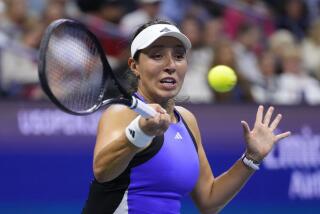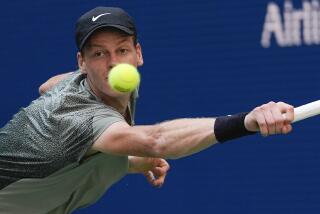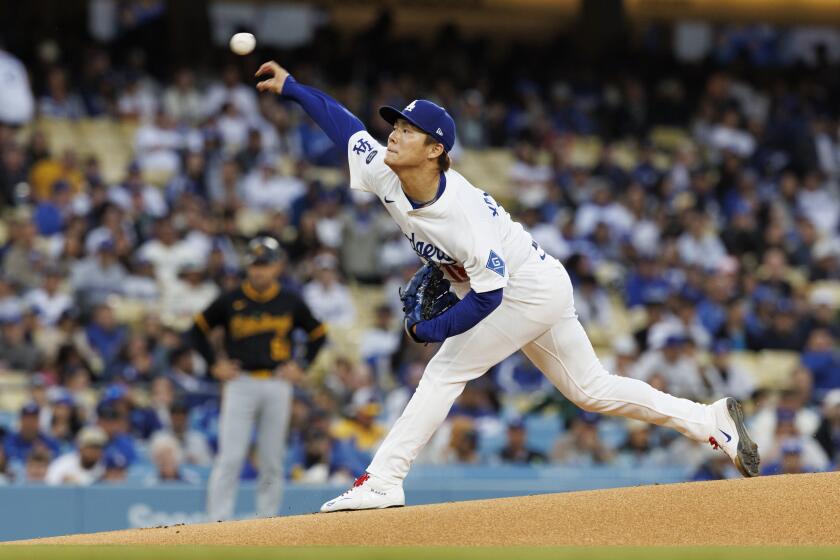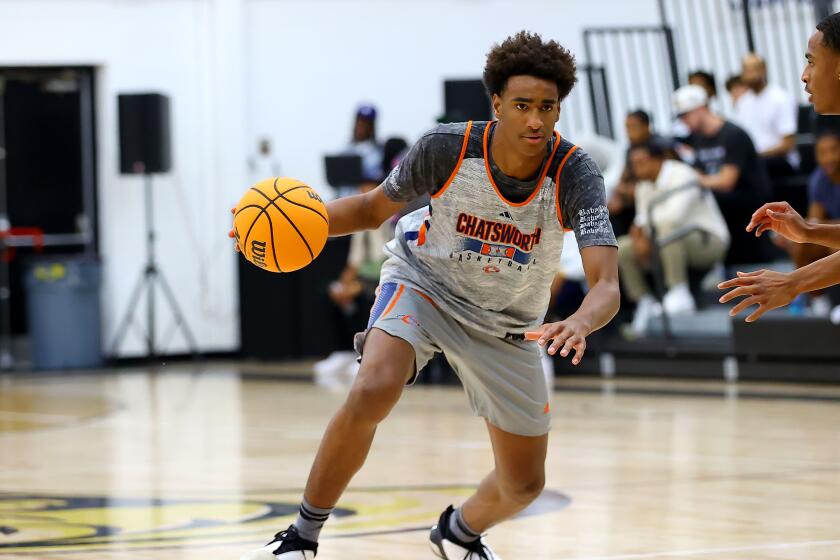For Mirjana Lucic-Baroni, happiness is just being here, at U.S. Open
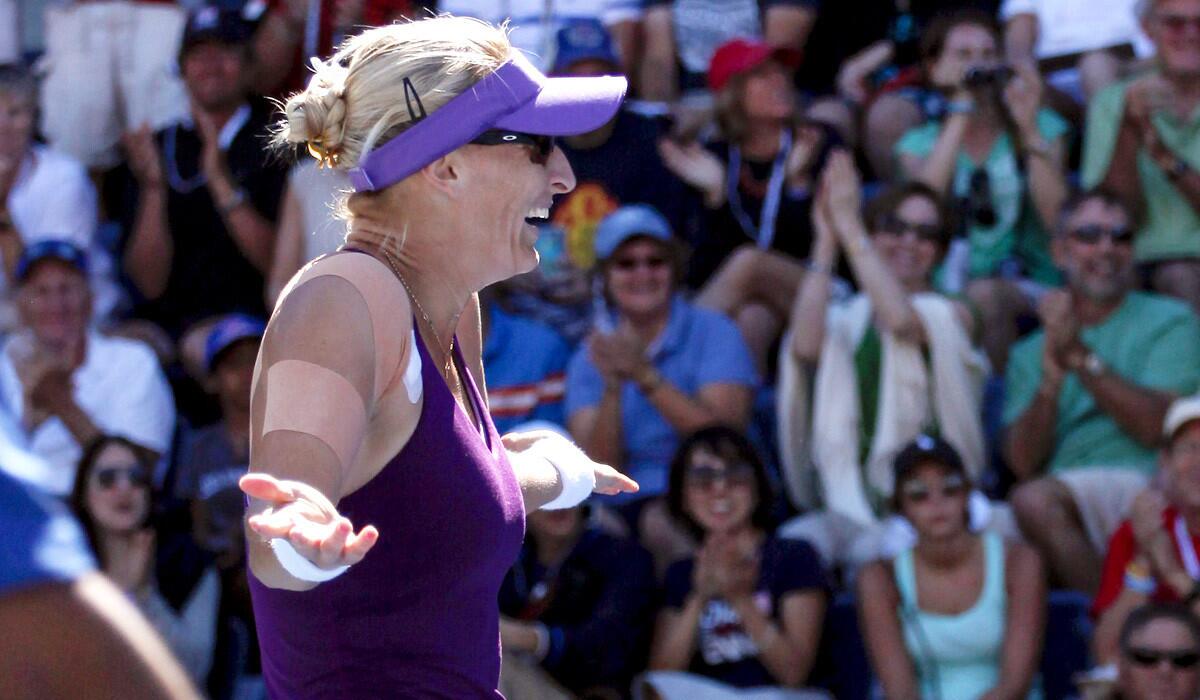
- Share via
Reporting from New York — The glamour match, Maria Sharapova and Caroline Wozniacki, took center court Sunday, each player seeking to further her fame, fortune and happiness. Mirjana Lucic-Baroni, match and tournament over, had already found hers.
Happiness, that is. Certainly not fortune and clearly the wrong kind of fame.
Lucic-Baroni had just lost her singles match in the fourth round of the U.S. Open, losing the last set at love in a 6-3, 2-6, 6-0 defeat.
That should make for teary times, anguish at missed opportunities. She had made 69 unforced errors and still kept flailing away in the swirling wind, while her opponent, Sara Errani of Italy, adjusted, kept the ball in play and waited for Lucic-Baroni to miss. Twenty-eight times in the last set, she did.
But joy and success on the pro tennis tour are measured differently by different people. To Roger Federer, Novak Djokovic, Rafael Nadal or Serena Williams, a fourth-round loss is a disaster. To Lucic-Baroni, getting that far was pure joy.
“I have been playing all these years,” she said. “It’s just that I haven’t had a lot of great success lately. . . . I’ve been fighting and battling through. I’ve been waiting for this, playing good tennis, having good results like I have the last two weeks.
“That’s what it is about for me. Not a billion dollars can compare to the feelings I felt in the last two weeks, fighting back and beating [second-seeded Simona] Halep here, fighting from the dead, basically . . .”
Fighting from the dead. For Lucic-Baroni, that is somewhat literal.
If her name is familiar, you are a true tennis fan. She is 32 now, and hasn’t been much of a blip on the sport’s radar for 15 years. She was 15-year-old Mirjana Lucic, a tennis prodigy — yes, another one — and she made headlines in 1997 by winning the first pro tournament she entered at that age, and in 1999 by beating Monica Seles on her way to the 1999 Wimbledon semifinals, before losing to Steffi Graf.
Around that time she also made headlines, very painful ones, when she sneaked away, in the middle of the night, with the rest of her family from home in Makarska, Croatia. She was escaping her father, Marinko, who she said abused her.
It was July 1998. She remembers it as the day Pete Sampras was beating Goran Ivanisevic of Croatia in the Wimbledon final.
According to a Tennis magazine story by Cindy Shmerler, headlined “Daddy Dearest,” Lucic had moved out of a rented house in Wimbledon village before the tournament began, when her father started to argue with her mother. She and her mother, Andelka, moved into Ivanisevic’s flat, minus Marinko.
She made the mixed doubles final with Mahesh Bhupathi, lost to Serena Williams and Max Mirnyi, immediately rushed back to Croatia and then, with the rest of the family and according to a plan, stole away from Marinko in the middle of the night. A few weeks later, she and the family, minus Marinko, flew to New York and have lived in the United States since.
Once what happened became public, Marinko sent a letter to a Croatian newspaper, denying he abused his daughter.
Soon, Lucic had disappeared from the public eye. So had her game.
An article in the New York Times this week, written by Scott Cacciola, characterized her long road back — if she is back — as “a tug of war between obscurity and irrelevance.”
She said that, for a while, she could not even afford to enter tournaments to attempt a comeback. Eventually, she moved from one lower-circuit event to another. When she won a match at Indian Wells in 2007, it was her first main-draw victory since 2002 at the French Open.
The same player who won the U.S. Open juniors at age 14 in 1996 came to this U.S. Open as a nearly hopeless qualifier. It was 18 years later, she had married Sarasota restaurant owner Daniel Baroni in 2011, and she was on an eight-match losing streak.
Then, she won her way into the main draw with three victories in qualifying and made it all the way to the fourth round with three more, including the third-round shocker that knocked out Halep.
“Best day of my life,” Lucic-Baroni said after that one.
She had lost in the first round of all three previous Grand Slam tournaments this year. In 1998, she had reached her career high ranking of No. 32. This year, she arrived at Flushing Meadows ranked No. 121.
That ranking will certainly improve now. Maybe this is it, her final high point. She is 5 feet 11, a big-hitter. Things like swirling wind and cat-quick returners such as Errani are tough for her to deal with. She is also making a comeback as one of the oldest players on the tour.
“It’s been a little while,” she said Sunday. “Today, I felt like my body just wasn’t willing . . . it kind of broke down everywhere. I have blisters, tape, pain everywhere.”
She also said she has happiness. That fame and fortune stuff can wait.
More to Read
Go beyond the scoreboard
Get the latest on L.A.'s teams in the daily Sports Report newsletter.
You may occasionally receive promotional content from the Los Angeles Times.

